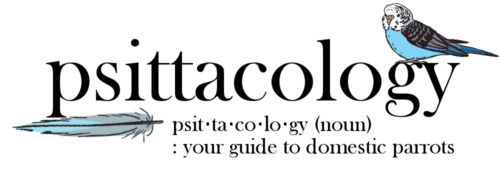The red-fronted lorikeet, also known as red-spotted or red-rumped lorikeet, is a brightly colored parrot that is native to the island of New Guinea. Despite their vibrant plumage and playful personalities, they’re not commonly kept as pets.
Below, let’s take a look at everything you need to know about the red-fronted lorikeet, including their natural habitat, diet, and behavior.
| Name(s) (common, scientific) | Red-fronted lorikeet, red-spotted lorikeet, red-rumped lorikeet, Hypocharmosyna rubronotata Older Latin names: Charmosyna rubronotata*, Glossopsitta rubronotata, Coriphilus rubronotatus |
| Natural habitat | New Guinea |
| Adult size | Up to 17 cm/6.7″ and 30–35 grams |
| Lifespan | 10+ years |
| Noise level | Medium |
Red-fronted lorikeet appearance
The red-fronted lorikeet (Hypocharmosyna rubronotata) is a small and brightly colored parrot native to the rainforests of central and eastern New Guinea.
You can recognize these lories by their green bodies. The males sport the typical red forehead patch the species was named for, as well as shoulder spots and patches of blue on the cheeks. Females are less colorful: they lack the red and blue, instead having streaked yellow cheek patches.
These birds have a short, hooked reddish beak and dark brown eyes. The legs and feet are pinkish. They reach a maximum length of only around 17 cm (6.7 inches) and weigh up to 35g, making them quite small!
There are two subspecies of red-fronted lorikeet:
- Hypocharmosyna rubronotata rubronotata
- Hypocharmosyna rubronotata kordoana: males have larger but paler head patches.
Did you know? The red-fronted lorikeet is very similar in looks to a closely related species, the red-flanked lorikeet (Hypocharmosyna placentis). Males of the latter sport red coloration on the throat, though, which today’s subject lacks.
Red-fronted lorikeet range & natural habitat
The red-spotted lorikeet is native to the lowlands of Papua New Guinea, where it can be found at up to 1,100 meters (3,600 ft) above sea level. It usually travels in small flocks of up to 50 individuals, sometimes with other lorikeet species tagging along.
The species has a relatively small range, though it’s found in a variety of habitats, from tropical forests to more open shrubby zones. These lorikeets have also made commercial coconut plantations their home
The population trend for Hypocharmosyna rubronotata appears to be stable, which is why it’s considered a species of Least Concern by the IUCN. Still, habitat loss and degradation caused by human activities such as logging, mining and agriculture could cause problems in the future.
Red-fronted lorikeet diet
Lorikeets have evolved to adapt to a specific diet based mostly on flowers, nectar, pollen and soft fruit. The red-fronted lorikeet is no exception in this, and it can be seen in its natural habitat flying between treetops in search of flowers.
They do eat some seeds as well, but are not quite as fond of them as most other parrot species. Their digestive systems aren’t made to digest most harder seeds.
Red-fronted lorikeet sounds
Most lorikeets are by no means quiet birds, and this one is no exception. Their calls are considered quite harsh, almost reminiscent of lovebirds. You can have a listen over at xeno-canto!
If you have any more questions about the red-fronted lorikeet, don’t hesitate to leave a comment below!
Sources & further reading
- Diamond, J., & Bishop, K. D. (2021). Avifauna of the Van Rees Mountains, New Guinea. Bulletin of the British Ornithologists’ Club, 141(4), 446-469.
- Parr, M., & Juniper, T. (2010). Parrots: a guide to parrots of the world. Bloomsbury Publishing.
- Smith, B. T., Mauck III, W. M., Benz, B. W., & Andersen, M. J. (2020). Uneven missing data skew phylogenomic relationships within the lories and lorikeets. Genome biology and evolution, 12(7), 1131-1147.
